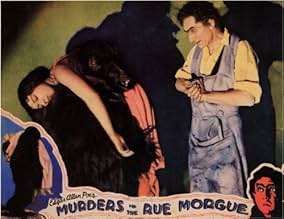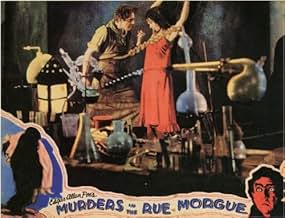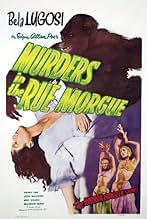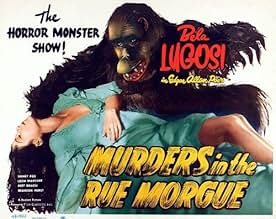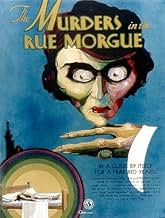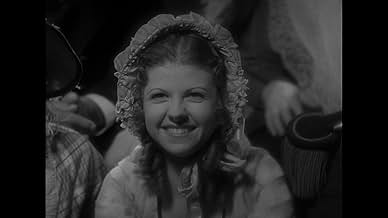VALUTAZIONE IMDb
6,3/10
5774
LA TUA VALUTAZIONE
Aggiungi una trama nella tua linguaA mad scientist seeks to mingle human blood with that of an ape, and resorts to kidnapping women for his experiments.A mad scientist seeks to mingle human blood with that of an ape, and resorts to kidnapping women for his experiments.A mad scientist seeks to mingle human blood with that of an ape, and resorts to kidnapping women for his experiments.
- Regia
- Sceneggiatura
- Star
- Premi
- 2 vittorie totali
Leon Ames
- Pierre Dupin
- (as Leon Waycoff)
Ted Billings
- Sideshow Spectator
- (non citato nei titoli originali)
Herman Bing
- Franz Odenheimer
- (non citato nei titoli originali)
Joe Bonomo
- Gorilla
- (non citato nei titoli originali)
Agostino Borgato
- Alberto Montani
- (non citato nei titoli originali)
Iron Eyes Cody
- Indian at Sideshow
- (non citato nei titoli originali)
Christian J. Frank
- Gendarme Using Snuff
- (non citato nei titoli originali)
Charles Gemora
- Erik, the Gorilla
- (non citato nei titoli originali)
Harrison Greene
- Sideshow Barker
- (non citato nei titoli originali)
Charlotte Henry
- Blonde Girl in Sideshow Audience
- (non citato nei titoli originali)
Recensioni in evidenza
Much creepier than any mad scientist and his monkey movie has a right to be. Much of the credit must go to cinematographer Karl Freund (The Last Laugh, Metropolis) who gives the movie the feel of a German horror film. Charles D. Hall's distorted sets also help make this often resemble a sound remake of "The Cabinet Of Dr. Caligari." The script has a very European flavor as well with lines that sometimes sound as if they were translated from another language. The ape is more convincing than all those later films because of quick cutting between an actual ape's snarling face and a man in a suit, the latter shown not enough to destroy the illusion. At one point stop motion is used to show the ape carrying a woman across the top of buildings a year before "King Kong!" There are three failings, however. Near the end is a long attempt at humor concerning French bureaucracy that hurts the build-up of tension. The other two failings come from the lab. They lay over one sequence a fog effect with the fog blowing at hurricane strength despite no apparent wind anywhere else in the shot. And at the end is a very obvious matte shot with lots of squiggly lines around the characters.
Murders in the Rue Morgue (1932)
King Kong was released by RKO in 1933, a story of an ape captured by white hairless apes and brought to a foreign land. And this is exactly the beginning of the 1932 Rue Morgue, as Bela Lugosi, playing Dr. Mirakle, appears as flamboyant sideshow impresario with an ape in a cage. His trick (if it is one) is knowing how to translate ape talk to English (or French, maybe, since we are in Paris). His point is that the apes are us, that evolution is true. "Can you understand what he says? Or have you forgotten?" Not the most honorable spokesman for science, no doubt, but he is a mad scientist, and is setting out to create some kind of unexplained human/ape hybrid.
The movie is filled with dramatic innovations, and a very high technical standard (for Universal, a minor studio player until this time). And the transfer to DVD is terrific. Ten minutes into the film, Lugosi breaks the fourth wall and looks into the camera to challenge the viewer to accept evolution and its consequences.. (The Scopes trial was 1925, so this is a hot topic.) Watch for the camera attached to the swing about 32 minutes in. There are echoes of Frankenstein (1931) with the madman and his doltish assistant, as well as the angry mobs. And there is Lugosi himself, with all the aura carrying over from his breakthrough in Dracula (also 1931).
The cinematography by Karl Freund is totally amazing. There are not astonishing tricks, just consistent, brilliant framing and lighting, scene after scene. (If only he had shot Dracula--oh, he did! Yes...check that out, too.) 1920s German Expressionist films find a true expression here (not Caligari, for sure, but a high water mark for American movies of the time). Simple things like shadows and angles, of course, but also moving camera in subtle ways (the camera falling slightly when approaching someone in a window, for example). Completely first rate.
It's common in these movies to have eccentric villains, grotesque monsters, and Gothic settings with wild special effects. And to have the common person as a balance to all this madness. These apply a little comic relief but in a silly way from our perspective. (The "common" person at the time in other movies was far more vivid and timeless, like Crawford or Cagney, but that would overwhelm the villains as well as the budget). In this case, one of the common folk is a resourceful doctor, and this search for the bad guy takes on a larger role than in the other monster movies.
The movie isn't a sparkling masterpiece. The acting throughout (even by Lugosi, really) isn't always spot on, but it works overall, and is consistent. There is a comic moment near the end (when we are most anxious for action) where the character have an argument in different languages, and it's so perky I'm assuming they felt they couldn't take it out, but it doesn't advance the plot. It does deal with Logosi's characteristic odd accent. And for fun, there is an anachronism, half an hour in, when a bicycle rides through the little town, decades before they were made like that.
It won't matter if you don't believe in evolution. The movie plays loose with the concept, and Dr. Mirakle says at one point, with his beady eyes: "Do you think your little candle can outshine the truth?"
King Kong was released by RKO in 1933, a story of an ape captured by white hairless apes and brought to a foreign land. And this is exactly the beginning of the 1932 Rue Morgue, as Bela Lugosi, playing Dr. Mirakle, appears as flamboyant sideshow impresario with an ape in a cage. His trick (if it is one) is knowing how to translate ape talk to English (or French, maybe, since we are in Paris). His point is that the apes are us, that evolution is true. "Can you understand what he says? Or have you forgotten?" Not the most honorable spokesman for science, no doubt, but he is a mad scientist, and is setting out to create some kind of unexplained human/ape hybrid.
The movie is filled with dramatic innovations, and a very high technical standard (for Universal, a minor studio player until this time). And the transfer to DVD is terrific. Ten minutes into the film, Lugosi breaks the fourth wall and looks into the camera to challenge the viewer to accept evolution and its consequences.. (The Scopes trial was 1925, so this is a hot topic.) Watch for the camera attached to the swing about 32 minutes in. There are echoes of Frankenstein (1931) with the madman and his doltish assistant, as well as the angry mobs. And there is Lugosi himself, with all the aura carrying over from his breakthrough in Dracula (also 1931).
The cinematography by Karl Freund is totally amazing. There are not astonishing tricks, just consistent, brilliant framing and lighting, scene after scene. (If only he had shot Dracula--oh, he did! Yes...check that out, too.) 1920s German Expressionist films find a true expression here (not Caligari, for sure, but a high water mark for American movies of the time). Simple things like shadows and angles, of course, but also moving camera in subtle ways (the camera falling slightly when approaching someone in a window, for example). Completely first rate.
It's common in these movies to have eccentric villains, grotesque monsters, and Gothic settings with wild special effects. And to have the common person as a balance to all this madness. These apply a little comic relief but in a silly way from our perspective. (The "common" person at the time in other movies was far more vivid and timeless, like Crawford or Cagney, but that would overwhelm the villains as well as the budget). In this case, one of the common folk is a resourceful doctor, and this search for the bad guy takes on a larger role than in the other monster movies.
The movie isn't a sparkling masterpiece. The acting throughout (even by Lugosi, really) isn't always spot on, but it works overall, and is consistent. There is a comic moment near the end (when we are most anxious for action) where the character have an argument in different languages, and it's so perky I'm assuming they felt they couldn't take it out, but it doesn't advance the plot. It does deal with Logosi's characteristic odd accent. And for fun, there is an anachronism, half an hour in, when a bicycle rides through the little town, decades before they were made like that.
It won't matter if you don't believe in evolution. The movie plays loose with the concept, and Dr. Mirakle says at one point, with his beady eyes: "Do you think your little candle can outshine the truth?"
I won't go into the plot details as many have done that before me, but "Murders in the Rue Morgue" is worth a look for several reasons.
The first is the overall look of the film from legendary DP Karl Freund (Dracula, Metropolis, and many others). The sets are outstanding, the lighting is great, and the overall atmosphere is perfect. Everything comes off as some creepy nightmare.
The second reason to see "Murders" is Bela Lugosi, who owns every scene he is in. He is sufficiently strange and intimidating as the mad doctor.
The third reason is the overall story line. OK, forget the whole mixing of the ape and human blood thing and this movie is very similar in plot line to "The Cabinet of Dr. Caligari", just substitute the ape for Cesare the Somnambulist. It also contains some very strong (for its time) scenes involving the doctor "administering" to his patients.
OK, now some things that aren't so hot.
First, the cutting between the man in the ape suit and the real ape's face is distracting. The shots don't match and some serious suspension of disbelief is required for this not to be a deal breaker. I've heard that Florey's film was cut against his wishes to add these scenes and remove others. That would explain why these scenes seem out of place.
Also, as others have referred to, the comic relief is really not very good. At the time, however, this type of thing was common in films that were thought to be very intense. The comedy was used to relieve the tension so the audience could be set up for the next batch of horrors. Most of it doesn't work in this film.
Overall, I felt this film was well worth a look, and I've watched it several times just to admire the outstanding work of Karl Freund.
The first is the overall look of the film from legendary DP Karl Freund (Dracula, Metropolis, and many others). The sets are outstanding, the lighting is great, and the overall atmosphere is perfect. Everything comes off as some creepy nightmare.
The second reason to see "Murders" is Bela Lugosi, who owns every scene he is in. He is sufficiently strange and intimidating as the mad doctor.
The third reason is the overall story line. OK, forget the whole mixing of the ape and human blood thing and this movie is very similar in plot line to "The Cabinet of Dr. Caligari", just substitute the ape for Cesare the Somnambulist. It also contains some very strong (for its time) scenes involving the doctor "administering" to his patients.
OK, now some things that aren't so hot.
First, the cutting between the man in the ape suit and the real ape's face is distracting. The shots don't match and some serious suspension of disbelief is required for this not to be a deal breaker. I've heard that Florey's film was cut against his wishes to add these scenes and remove others. That would explain why these scenes seem out of place.
Also, as others have referred to, the comic relief is really not very good. At the time, however, this type of thing was common in films that were thought to be very intense. The comedy was used to relieve the tension so the audience could be set up for the next batch of horrors. Most of it doesn't work in this film.
Overall, I felt this film was well worth a look, and I've watched it several times just to admire the outstanding work of Karl Freund.
After the enormous success of Tod Browning's "Dracula" in 1931, producer Carl Laemmle Jr. finally proved that his vision had been correct and that the horror genre was an excellent source of stories to film. With that in mind, he began to work immediately in a follow up for that success with an adaptation of Mary Shelley's immortal novel, "Frankenstein", in the expressionist Gothic style of Browning's film. The film was set to be written and directed by French director Robert Florey and starred by the recently discovered Hungarian star of "Dracula": Bela Lugosi. However, people at Universal changed the plans and assigned the film to British director James Whale, who had a different idea for the movie and replaced Lugosi with Boris Karloff. Owing a film to both Florey and Lugosi, Universal gave them a project based on a tale by Edgar Allan Poe: "Murders in the Rue Morgue".
Set in Paris during the late 19th Century, "Murders in the Rue Morgue" is the tale of a series of unsolved crimes where women are abducted and murdered by an unknown method. Since the murders began to take place after a carnival arrived to the city, young medicine student Pierre Dupin (Leon Ames) suspects that Dr. Mirakle (Bela Lugosi), a scientist who owns one of the sideshow attractions, is behind the crimes, but so far he finds himself unable to prove it. His suspicion has its source in the fact that Mirakle has claimed to be looking for a way to finally prove that man and ape are related, and apparently has been experimenting on his sideshow attraction: an intelligent ape named Erik, which Mirakle claims is the missing link. Dupin fears that Mirakle's experiments are related to the murders, but the truth is far more horrible than what he thinks.
"Murders in the Rue Morgue" is not exactly a faithful adaptation of Poe's short story, as the script (written by Tom Reed, Dale Van Every and Robert Florey himself) focuses more on the reasons behind the murders than on the investigation done to solve the case. It is because of this reason that it is Dr. Mirakle who is in the spotlight while Poe's famous character, Dupin, has been transformed from cunning detective to a young student of medicine. With this change, the writers allow themselves to completely focus on horror, and deliver one of the darkest and most violent stories among Universal's classic horrors. However, as many have already pointed out, the story is not only an exploration of Poe's tale, but also a charming tribute to German expressionism's most celebrated triumph, "Das Cabinet Des Dr. Caligari", as the plot mirrors the classic silent film in more than one way.
The tribute to "Caligari" is not only a part of the script, as director Florey, aided by the legendary cinematographer Karl Freund and the wonderful art direction by Charles D. Hall, extended the tribute to the overall visual look of the film, following the expressionist style to the letter with an amazing use of light and shadows to create a powerful and haunting atmosphere. However, not everything is lifted from German expressionism, as Florey adds his own realist style to the mix resulting in a powerful combination that enhances the violence of the script. As the film was done before the Production Code was introduced, Florey manages to bring to life a lot of the vicious images of the script with an amount of detail that would be impossible a few years later. Sadly, Florey's skills at directing actors aren't as good as his skills with the camera, and some bad performances end up damaging the movie a lot.
While Florey doesn't seem to direct his actors as good as he does with the visuals, Bela Lugosi shows off his talent in a tremendous performance that's probably among the best of his career. As Mirakle, Lugosi is incredibly believable as a demented scientist, and despite being one of his most menacing roles he even manages to be sympathetic at times. The sadly ill-fated Sidney Fox is also good as Camille, the damsel in distress of this eerie horror, but sadly her counterpart, Leon Ames, isn't up to the challenge. While he later proved to be a talented actor, in this movie Ames delivers an awful performance that looks stagy and simply out of place in the movie. Bert Roach, who plays his sidekick, is not much better, as his delivery of comic relief is mediocre at best and ludicrous at worst.
This varying quality of the performances and the sharp contrast between them and the superb visual look of the movie may had played a part in the relatively disappointing reception the film had at box office, but the main reasons the movie failed was probably the fact that the audience wasn't ready for the dark nature of the plot and the violence displayed on screen. In fact, there are rumors stating that Universal removed almost 20 minutes of the original cut, taking away scenes supposedly too violent for being released. Anyways, whether this rumor is true or not is ultimately irrelevant, as the film's main problem is still in the actors' performances and that's something that missing footage hardly could improve. It is a shame that one of Lugosi's best performances ends up in the same film as one of Ames' worst.
Despite its many troubles, Robert Florey's "Murders in the Rue Morgue" is still an effective tale of horror and mystery that keeps the classic Universal feeling to the max. Dark and atmospheric, it is also an unusual movie due to its raw portrayal of violence on film. While not exactly a classic of the level of Universal films like "Frankenstein" or "The Black Cat", this movie is definitely a must see if only for Karl Freund's masterful cinematography and Bela Lugosi's amazing performance. 7/10
Set in Paris during the late 19th Century, "Murders in the Rue Morgue" is the tale of a series of unsolved crimes where women are abducted and murdered by an unknown method. Since the murders began to take place after a carnival arrived to the city, young medicine student Pierre Dupin (Leon Ames) suspects that Dr. Mirakle (Bela Lugosi), a scientist who owns one of the sideshow attractions, is behind the crimes, but so far he finds himself unable to prove it. His suspicion has its source in the fact that Mirakle has claimed to be looking for a way to finally prove that man and ape are related, and apparently has been experimenting on his sideshow attraction: an intelligent ape named Erik, which Mirakle claims is the missing link. Dupin fears that Mirakle's experiments are related to the murders, but the truth is far more horrible than what he thinks.
"Murders in the Rue Morgue" is not exactly a faithful adaptation of Poe's short story, as the script (written by Tom Reed, Dale Van Every and Robert Florey himself) focuses more on the reasons behind the murders than on the investigation done to solve the case. It is because of this reason that it is Dr. Mirakle who is in the spotlight while Poe's famous character, Dupin, has been transformed from cunning detective to a young student of medicine. With this change, the writers allow themselves to completely focus on horror, and deliver one of the darkest and most violent stories among Universal's classic horrors. However, as many have already pointed out, the story is not only an exploration of Poe's tale, but also a charming tribute to German expressionism's most celebrated triumph, "Das Cabinet Des Dr. Caligari", as the plot mirrors the classic silent film in more than one way.
The tribute to "Caligari" is not only a part of the script, as director Florey, aided by the legendary cinematographer Karl Freund and the wonderful art direction by Charles D. Hall, extended the tribute to the overall visual look of the film, following the expressionist style to the letter with an amazing use of light and shadows to create a powerful and haunting atmosphere. However, not everything is lifted from German expressionism, as Florey adds his own realist style to the mix resulting in a powerful combination that enhances the violence of the script. As the film was done before the Production Code was introduced, Florey manages to bring to life a lot of the vicious images of the script with an amount of detail that would be impossible a few years later. Sadly, Florey's skills at directing actors aren't as good as his skills with the camera, and some bad performances end up damaging the movie a lot.
While Florey doesn't seem to direct his actors as good as he does with the visuals, Bela Lugosi shows off his talent in a tremendous performance that's probably among the best of his career. As Mirakle, Lugosi is incredibly believable as a demented scientist, and despite being one of his most menacing roles he even manages to be sympathetic at times. The sadly ill-fated Sidney Fox is also good as Camille, the damsel in distress of this eerie horror, but sadly her counterpart, Leon Ames, isn't up to the challenge. While he later proved to be a talented actor, in this movie Ames delivers an awful performance that looks stagy and simply out of place in the movie. Bert Roach, who plays his sidekick, is not much better, as his delivery of comic relief is mediocre at best and ludicrous at worst.
This varying quality of the performances and the sharp contrast between them and the superb visual look of the movie may had played a part in the relatively disappointing reception the film had at box office, but the main reasons the movie failed was probably the fact that the audience wasn't ready for the dark nature of the plot and the violence displayed on screen. In fact, there are rumors stating that Universal removed almost 20 minutes of the original cut, taking away scenes supposedly too violent for being released. Anyways, whether this rumor is true or not is ultimately irrelevant, as the film's main problem is still in the actors' performances and that's something that missing footage hardly could improve. It is a shame that one of Lugosi's best performances ends up in the same film as one of Ames' worst.
Despite its many troubles, Robert Florey's "Murders in the Rue Morgue" is still an effective tale of horror and mystery that keeps the classic Universal feeling to the max. Dark and atmospheric, it is also an unusual movie due to its raw portrayal of violence on film. While not exactly a classic of the level of Universal films like "Frankenstein" or "The Black Cat", this movie is definitely a must see if only for Karl Freund's masterful cinematography and Bela Lugosi's amazing performance. 7/10
A crazed scientist commits vile MURDERS IN THE RUE MORGUE to promote his theories concerning the relationship between human & ape biology.
Bela Lugosi dominates this rather fascinating little foray into terror, his mad mesmerizing eyes & theatrical gestures a natural complement to the film's Grand Guignol qualities. Listening to the world of weariness in his voice as he delivers a line like `Will my search never end?' makes only more poignant this fine actor's eventual descent into drug addicted obscurity.
Pert, pretty little Sidney Fox -she actually receives top billing over Lugosi - gives a pleasing performance as the unfortunate choice of the ape's interest (the plot is never really clear as to what, exactly, Lugosi is attempting to accomplish with his gruesome experiments). Leon Waycoff is hopeless as a romantic lead, but with an eventual name change to Leon Ames, he was to become one of Hollywood's most durable character actors.
The supporting cast is quite good: plump Bert Roach as a nervous medical student; sepulchral D'Arcy Corrigan as a sardonic morgue keeper; Arlene Francis, who has the dubious honor of featuring in one of Universal's most horrific murder scenes; and Noble Johnson, important Black actor & silent film star, here performing in whiteface (as he often did) as Lugosi's mute henchman.
Movie mavens will spot some familiar faces in unbilled roles: Harry Holman as Miss Fox's silly, obese landlord; Herman Bing, Torben Meyer & Agostino Borgato as three ear-witnesses to one of the murders; Tempe Pigott as an old crone with very bad teeth; and Charlotte Henry as a lovely young lady.
Based somewhat loosely on the classic detective story by Edgar Allan Poe, the film also owes much in plot to Leroux' The Phantom of the Opera and in style to Wiene's THE CABINET OF DR. CALIGARI. Karl Freund's cinematography is first rate, as is the expressionistic set design by Herman Rosse, with buildings tilted or leaning at crazed angles. The contribution of master makeup artist Jack Pierce is also evident.
Bela Lugosi dominates this rather fascinating little foray into terror, his mad mesmerizing eyes & theatrical gestures a natural complement to the film's Grand Guignol qualities. Listening to the world of weariness in his voice as he delivers a line like `Will my search never end?' makes only more poignant this fine actor's eventual descent into drug addicted obscurity.
Pert, pretty little Sidney Fox -she actually receives top billing over Lugosi - gives a pleasing performance as the unfortunate choice of the ape's interest (the plot is never really clear as to what, exactly, Lugosi is attempting to accomplish with his gruesome experiments). Leon Waycoff is hopeless as a romantic lead, but with an eventual name change to Leon Ames, he was to become one of Hollywood's most durable character actors.
The supporting cast is quite good: plump Bert Roach as a nervous medical student; sepulchral D'Arcy Corrigan as a sardonic morgue keeper; Arlene Francis, who has the dubious honor of featuring in one of Universal's most horrific murder scenes; and Noble Johnson, important Black actor & silent film star, here performing in whiteface (as he often did) as Lugosi's mute henchman.
Movie mavens will spot some familiar faces in unbilled roles: Harry Holman as Miss Fox's silly, obese landlord; Herman Bing, Torben Meyer & Agostino Borgato as three ear-witnesses to one of the murders; Tempe Pigott as an old crone with very bad teeth; and Charlotte Henry as a lovely young lady.
Based somewhat loosely on the classic detective story by Edgar Allan Poe, the film also owes much in plot to Leroux' The Phantom of the Opera and in style to Wiene's THE CABINET OF DR. CALIGARI. Karl Freund's cinematography is first rate, as is the expressionistic set design by Herman Rosse, with buildings tilted or leaning at crazed angles. The contribution of master makeup artist Jack Pierce is also evident.
Lo sapevi?
- QuizMany censors cut parts of the death scenes of the woman (Arlene Francis) of the streets - eliminating her stabbing and being tied to the cross beams.
- BlooperIn many scenes, the close-up of a chimpanzee is used for the gorilla.
- Citazioni
Dr. Mirakle: [Responding to an audience member who has accused him of heresy] Heresy? Do they still burn men for heresy? Then burn me monsieur, light the fire! Do you think your little candle will outshine the flame of truth?
- Curiosità sui creditiAt the end of the film, the cast list is shown again with the heading, "A GOOD CAST IS WORTH REPEATING...."
- Versioni alternativeWhen originally released theatrically in the UK, the BBFC made cuts to secure a 'A' rating. All cuts were waived in 2001 when the film was granted a '12' certificate for home video.
- ConnessioniEdited into Mondo Lugosi - A Vampire's Scrapbook (1987)
I più visti
Accedi per valutare e creare un elenco di titoli salvati per ottenere consigli personalizzati
Dettagli
- Data di uscita
- Paese di origine
- Lingue
- Celebre anche come
- Murders in the Rue Morgue
- Luoghi delle riprese
- Azienda produttrice
- Vedi altri crediti dell’azienda su IMDbPro
Botteghino
- Budget
- 190.000 USD (previsto)
- Tempo di esecuzione
- 1h 1min(61 min)
- Colore
- Proporzioni
- 1.37 : 1
Contribuisci a questa pagina
Suggerisci una modifica o aggiungi i contenuti mancanti


